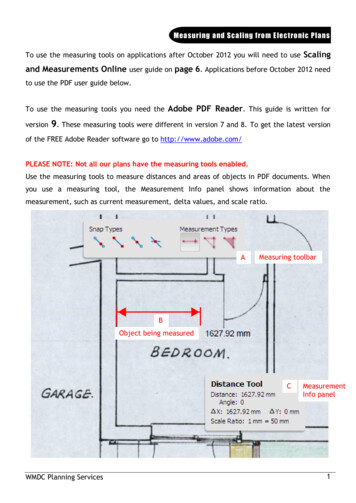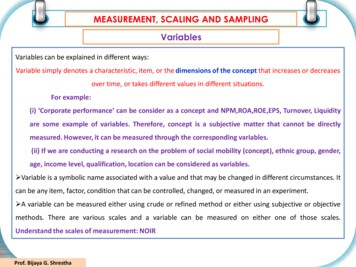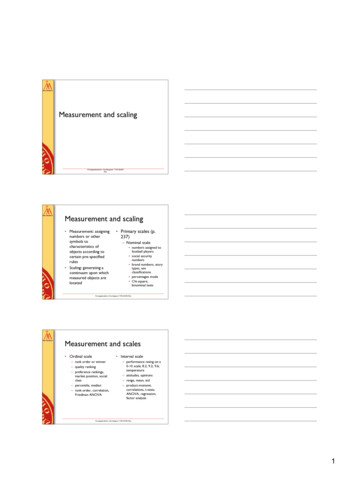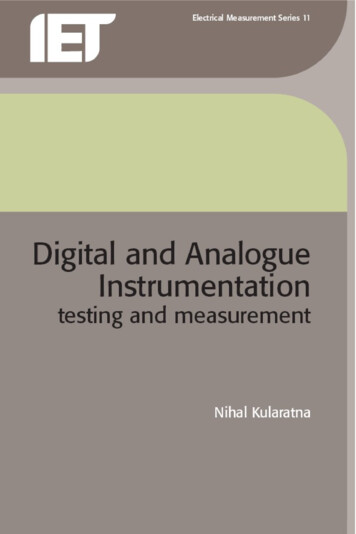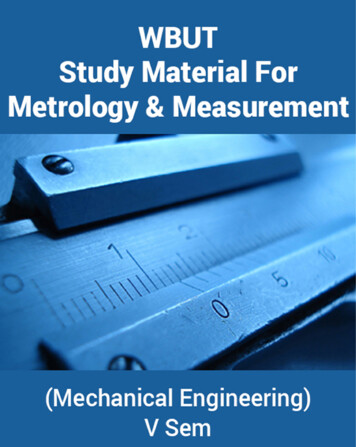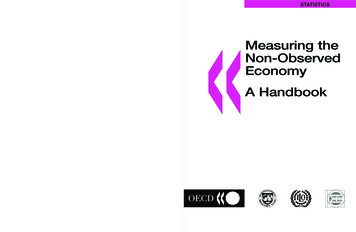
Transcription
2002STATISTICSMeasuring the Non-Observed EconomyA HandbookGood-quality national accounts are vital for economic policy making and research. An important aspect of theirquality is the extent to which they cover all economic activities. However, exhaustive coverage is difficult to achieve.Activities may have been excluded from the statistics used to compile the national accounts because they areunderground, illegal, informal, household production for own final use, or due to deficiencies in the basic datacollection system. Such activities are said to comprise the non-observed economy, and including them in thenational accounts is referred to as measurement of the non-observed economy.Measuring theNon-ObservedEconomyThe aim of the Handbook is to identify and promote best practice for measurement of the non-observed economythat is consistent with international standards and, in particular, with the 1993 System of National Accounts.In addition, the Handbook indicates how stand-alone estimates of the informal sector, of underground production,of household production for own final use, and of some illegal activities, may be obtained.Further reading:System of National Accounts 1993OECD's books, periodicals and statistical databases are now available via www.SourceOECD.org, our online library.This book is available to subscribers to the following SourceOECD themes:Emerging EconomiesGeneral Economics and Future StudiesStatistics Sources and MethodsTransition EconomiesOECD EssentialsNational Accounts and Historical StatisticsAsk your librarian for more details of how to access OECD books online, or write to us atSourceOECD@oecd.orgThis work is published under the auspices of theOECD’s Centre for Co-operation withNon-Members (CCNM). The Centre promotesand co-ordinates the OECD’s policy dialogue andco-operation with economies outside the OECD area.For the CCNM website, please see:www.oecd.org/sge/ccnmwww.oecd.orgISBN 92-64-19745-130 2002 05 1 P-:HSTCQE V \YZ :Measuring the Non-Observed Economy: A HandbookThe Handbook is aimed at producers and users of macroeconomic statistics. The primary audience is the staffof statistical offices involved in the collection of macroeconomic statistics and preparation of the national accounts.In addition, the Handbook may prove useful to those who have reason to be concerned about overall levels ofeconomic production and what may be missing. It may also benefit researchers and journalists who are confrontedwith a plethora of alternative measures of the underground, hidden, shadow economy, etc., and who would like toknow why these measures are all different and which can be regarded as the most reliable.«STATISTICSA Handbook
OECD, 2002. Software: 1987-1996, Acrobat is a trademark of ADOBE.All rights reserved. OECD grants you the right to use one copy of this Program for your personal use only. Unauthorised reproduction,lending, hiring, transmission or distribution of any data or software is prohibited. You must treat the Program and associated materialsand any elements thereof like any other copyrighted material.All requests should be made to:Head of Publications Service,OECD Publications Service,2, rue André-Pascal,75775 Paris Cedex 16, France.
«STATISTICSMeasuring theNon-ObservedEconomyA Handbook
ORGANISATION FOR ECONOMIC CO-OPERATIONAND DEVELOPMENTPursuant to Article 1 of the Convention signed in Paris on 14th December 1960, and which came intoforce on 30th September 1961, the Organisation for Economic Co-operation and Development (OECD)shall promote policies designed:– to achieve the highest sustainable economic growth and employment and a rising standard ofliving in Member countries, while maintaining financial stability, and thus to contribute to thedevelopment of the world economy;– to contribute to sound economic expansion in Member as well as non-member countries in theprocess of economic development; and– to contribute to the expansion of world trade on a multilateral, non-discriminatory basis inaccordance with international obligations.The original Member countries of the OECD are Austria, Belgium, Canada, Denmark, France,Germany, Greece, Iceland, Ireland, Italy, Luxembourg, the Netherlands, Norway, Portugal, Spain,Sweden, Switzerland, Turkey, the United Kingdom and the United States. The following countriesbecame Members subsequently through accession at the dates indicated hereafter: Japan(28th April 1964), Finland (28th January 1969), Australia (7th June 1971), New Zealand (29th May 1973),Mexico (18th May 1994), the Czech Republic (21st December 1995), Hungary (7th May 1996), Poland(22nd November 1996), Korea (12th December 1996) and the Slovak Republic (14th December 2000). TheCommission of the European Communities takes part in the work of the OECD (Article 13 of the OECDConvention).Publié en français sous le titre :Manuel sur la mesure de l’économie non observée OECD 2002Permission to reproduce a portion of this work for non-commercial purposes or classroom use should be obtainedthrough the Centre français d’exploitation du droit de copie (CFC), 20, rue des Grands-Augustins, 75006 Paris,France, tel. (33-1) 44 07 47 70, fax (33-1) 46 34 67 19, for every country except the United States. In the United Statespermission should be obtained through the Copyright Clearance Center, Customer Service, (508)750-8400,222 Rosewood Drive, Danvers, MA 01923 USA, or CCC Online: www.copyright.com. All other applications forpermission to reproduce or translate all or part of this book should be made to OECD Publications, 2, rue André-Pascal,75775 Paris Cedex 16, France.
FOREWORD AND ACKNOWLEDGEMENTSComplete coverage of economic production is a vital aspect of the quality of the national accounts.This exhaustiveness is hard to achieve because of the difficulties in accounting for certain types ofproductive activities. Activities that are missing from the basic data used to compile the nationalaccounts because they are underground, illegal, informal, household production for own final use, ordue to deficiencies in the basic data collection system are referred to as non-observed. They are said tocomprise the non-observed economy (NOE), and including them in the national accounts is referred to asmeasurement of the NOE.Given the wide range of possible approaches to NOE measurement, there is a need to identify andpromote international best practice. This is the aim of the Handbook. It presents a systematic strategyfor achieving exhaustive estimates of gross domestic product that is consistent with internationalstandards and, in particular, with the 1993 System of National Accounts.The Handbook was put together by a team drawn from national and international statisticalorganisations. The principal contributors were Adriaan Bloem, Manlio Calzaroni, Jacques Charmes,Michael Colledge (editor), Ralf Hussmanns, Youri Ivanov, Brugt Kazemier, Andrei Kosarev, RonaldLuttikhuizen, Sabina Ronconi, Manik Shrestha, Seppo Varjonen, Peter van de Ven and Denis Ward.Derek Blades provided detailed comments on all chapters. Helpful advice and comments were alsoreceived from Misha Belkindas, Peter Harper, Anne Harrison, Ralf Hein, Victor Holovko, Olga Ivanova,Irina Masakova, Paul McCarthy, Brian Newson, Vitezslav Ondrus, Gerhard Reinecke, Silke Stapel,Alexander Surinov and Jiri Vopravil. Particular thanks are due to the Italian National Statistical Institute(Istat), the Russian Federation State Statistical Committee, and Statistics Netherlands for their activesupport of this project.An electronic copy of the Handbook and supporting documentation are available on the Internet atwww.oecd.org. Comments on the Handbook are welcomed and should be e-mailed to noehandbook@oecd.org.They will be taken into account in any future revision.Enrico GiovanniniChief Statistician and Director of the Statistics DirectorateOrganisation for Economic Co-operation and DevelopmentCarol S. CarsonDirectorStatistics DepartmentInternational Monetary FundAbimbola Sylvester YoungDirectorBureau of StatisticsInternational Labour OrganisationMikhail KorolevChairmanInterstate Statistical Committee of the Commonwealth of Independent States OECD 20023
TABLE OF CONTENTSForeword and Acknowledgements .Abbreviations and Acronyms .37Chapter 1.Introduction .9Chapter 2.Conceptual Framework .17Chapter 3.Notions of the Non-Observed Economy .35Chapter 4.Assessment of National Accounts.49Chapter 5.National Accounts Methods to Achieve Exhaustiveness .67Chapter 6.Assessment and Improvement of Data Collection Programme .95Chapter 7.Implementation Strategy . 123Chapter 8.Underground Production . 137Chapter 9.Illegal Production . 149Chapter 10. Informal Sector Production . 159Chapter 11. Household Production for Own Final Use. 177Chapter 12. Macro-model Methods . 185Annexes1.2.3.4.5.References .Glossary .Data Requirements and Sources .Analytical Frameworks for the Non-Observed Economy .IMF Data Quality Assessment – Generic Framework .195205231238247List of Figures2.1. (1993 SNA Figure 17.1) Population and labour concepts . 273.1. Istat analytical framework . 433.2. Production income framework . 474.1. Example of structure of data quality assessment framework for national accounts estimates . 635.1. Estimation of GDP by input of labour method (Italian approach) . 807.1. Elements of NOE measurement implementation strategy . 1277.2. Enterprises in household sector by type of production. 13310.1. Fifteenth ICLS: Framework for informal sector definition . 164List of Tables3.1. Unit by activity by cause classification of non-observed activities .3.2. Classification of NOE by registration of units and labour input . OECD 200245465
Measurement of the Non-Observed Economy: A Handbook4.1. Primary income of households according to the national accounts and income tax statisticsfor the Netherlands 1977-1985 .4.2. Upper limit of underground transactions missing from personal expenditure .4.3. Upper limit of underground transactions missing from expenditure based GDP .4.4. NOE upper bound for the Netherlands, 1979 .4.5. Eurostat national accounts process table, layer 1: Quantitative overview.6.1. Survey registration and collection characteristics by size of enterprise .52575759661086 OECD 2002
ABBREVIATIONS AND ACRONYMS(See Annex 2 for definitions of terms)1968 SNA1993 SNACOICOPCPCCPIDQAFESA C, Rev. 3IstatNSONSSNOENPISHPPISDDSVATSystem of National Accounts 1968System of National Accounts 1993Classification of Individual Consumption by PurposeCentral Product ClassificationConsumer Price IndexData Quality Assessment Framework (IMF)European System of Accounts 1995Financial Intermediation Services Indirectly MeasuredGross Domestic ProductGeneral Data Dissemination Standard (IMF)Gross Fixed Capital FormationState Statistical Committee (abbreviation derived from the Russian)Household Expenditure SurveyHarmonised SystemInternational Conference of Labour StatisticiansInternational Monetary FundInstitut National de la Statistique et des Études Économiques, FranceInternational Standard Industrial Classification, Revision 3 (United Nations)Italian National Statistical InstituteNational Statistical OfficeNational Statistical SystemNon-observed EconomyNon-profit Institutions Serving HouseholdsProducer Price IndexSpecial Data Dissemination Standard (IMF)Value Added Tax7 OECD 2002
Chapter 1INTRODUCTION1.2.1.3.1.4.1.5.1.6.Scope and Objectives .Handbook Users .Concepts and Terminology .Measurement Strategy .Roadmap to Handbook.By Chapter Content .By User .121313141515169 OECD 2002
1. INTRODUCTION1.1.Good quality national accounts are vital for economic policy making and research. An importantaspect of their quality is the extent to which they cover all economic activities. Exhaustive coverage isdifficult to achieve because of the wide range of economic activities, some of which are deliberatelyconcealed from observation by those responsible for them.1.2.Lack of coverage causes problems for users both in terms of levels and trends. Levels of grossdomestic product (GDP) and other data are downward biased, thus giving an inaccurate impression of theeconomy and impeding international comparability. This can be of great significance in situations where,for example, monetary contributions made or received by a country depend on its GDP or when poverty ismeasured by GDP per head or environmental standards are measured by pollutant emission per unit ofGDP. Similarly, biases in trend estimates can be expected if the economic activities missing from GDPgrow at different rates from those included. For example, it is often conjectured that underground andinformal sector activities are expanding at precisely the time the official economy is contracting.1.3.For the national accountants, lack of coverage causes imbalances in the internal consistency ofthe accounts because parts of economic transactions may be measured whilst other parts are not. Forexample, household expenditures on goods and services produced underground may be measuredbecause the purchasers have no reason to hide their purchases, whereas the corresponding productionactivities are not reported by the producers.1.4.A lot of media attention is paid to the possibility of missing economic activities, and reportsoften suggest that the GDP figures published by national statistical offices exclude large parts of theeconomy. These reports challenge the credibility of national accounts estimates and often quoteassessments of the underestimation. The problem is that many media reports are based on researchmethodologies with one, or both, of two major weaknesses. First, these methods frequently fail todefine exactly what is to be measured and thus, possibly, missed. This lack of precision regarding themeasurement target is epitomised by the wide range of different terms in common use – hiddeneconomy, shadow economy, parallel economy, subterranean economy, informal economy, casheconomy, black market – to mention just a few. There is no common understanding whether they allmean the same thing, and if not, what relationships they have to one another. Capital flight, tax evasion,shuttle trade, theft and extortion are all lumped together as undesirable or illegal activities that arebeing grossly underestimated by the official figures.1.5.The second problem is the dependence of many estimation methods upon simplisticassumptions that cannot be justified. For example, the so-called “monetary models” assume thatchanges in the patterns of currency demand can be attributed entirely to, and reflect accurately,changes in missing economic activities. Another popular model is based on changes in consumption ofelectricity. Such methods make inadequate use of the wealth of pertinent economic data available andthere is no obvious way in which their findings can be combined with others to provide more reliablemeasures.1.6.One of the reasons that these macro-models get so much attention is that national statisticaloffices do not explain their own methods sufficiently, and thus users suppose that other methods areneeded and useful. This discussion also raises questions about what is meant by informal,underground, illegal, unmeasured, unrecorded, untaxed, etc., activities. How do these activities relate OECD 200211
Measurement of the Non-Observed Economy: A Handbookto one another? Are these activities part of or different from the shadow economy, the cash economy,the parallel economy, the subterranean economy, etc.? What are the best methods for estimating suchactivities? How reliable are the current figures? Where do capital flight, tax evasion and the shuttletrade fit in? The aim of this Handbook is to provide a common language and to put measurements ofeconomic production on a firm footing, for the benefit of survey statisticians, national accountants, andusers of macroeconomic data. The Handbook is intended to reflect a convergence of opinion amongststatisticians and national accounts experts as to what constitutes best practice.1.2.Scope and Objectives1.7.The conceptual framework for the Handbook is provided by relevant international standards, inparticular the System of National Accounts 1993 (1993 SNA) produced by five internationalorganisations (Commission of European Communities et al., 1993). Thus, the scope of the Handbook iseconomic production as defined by the 1993 SNA. This provides a solid basis but also implies arestriction on the range of issues that are considered. In particular, as further elaborated in Chapter 2,the Handbook does not include the measurement of many services provided by household membersto themselves, such as housework or preparing meals, because they are not within the 1993 SNAproduction boundary. These are not regarded as being missing production.1.8.The main focus of the Handbook (Chapters 2-7) is to provide guidance on how to produceexhaustive estimates of GDP. This means ensuring that as many productive activities as possible areobserved, i.e., directly measured in the basic data on production, incomes, and expenditures from whichthe national accounts are compiled. It also means ensuring that non-observed activities are neverthelessaccounted for, i.e., indirectly measured during compilation of the national accounts.1.9.The groups of activities most likely to be non-observed are those that are underground, illegal,informal sector, or undertaken by households for their own final use. Activities may also be missed because ofdeficiencies in the basic statistical data collection programme. These groups of activities are referred to in thisHandbook as the problem areas. Activities not included in the basic data because they are in one or moreof these problem areas are collectively said to comprise the non-observed economy (NOE). Thus,measurement of the non-observed economy involves action on two fronts: improvements in direct measurement by the data collection programme, resulting in fewernon-observed activities and hence fewer non-measured activities; and improvements in indirect measurement during compilation of the national accounts, resultingin fewer non-measured activities.1.10. Although the main goal of the Handbook is to help statisticians produce exhaustive estimates ofGDP, it is recognised that there are many issues in addition to exhaustiveness closely related to theNOE. In particular, in many countries, especially developing ones, a large number of persons areinvolved in informal sector production, which has a very significant role in employment creation,income generation and poverty reduction. Data on the size and characteristics of the informal sectorand its contribution to GDP are thus required for research and policy making. In response to thisdemand, the Handbook provides advice on the production of stand-alone statistics for the informalsector and of household production undertaken for own final use.121.11. Other issues that are sometimes considered to be related to the NOE are capital flight, shuttletrade, cross border shopping, tax evasion, and drug trafficking. Some of the concern that officialstatistics do not properly reflect the magnitude of such activities stems from a misunderstanding ofwhat is included in the GDP. In particular, capital flight and tax evasion are not productive activities andthus are not measured in the GDP. Whilst it is not the aim of the Handbook to deal explicitly with theseissues, it does provide some guidance. In particular, it details methods for the production of standalone statistics for underground production and describes its relationship to tax evasion, shuttle tradeand other items commonly associated with the underground economy. It also discusses the mostcommon types of illegal production. OECD 2002
Introduction1.12. It is worth emphasising what the Handbook does not attempt to do. It does not lay claim topresenting new material, nor to providing the single best solution. Rather it is a compendium of existinggood practices, with guidance on how they might best be used. Furthermore, it does not aim at reductionof underground, illegal, informal sector activities or household production for own final use. Rather itaims at ensuring that productive activities are observed to the extent possible, and that those that arenon-observed are nevertheless measured in the national accounts. In doing so, the Handbook mayprovide some ideas regarding the causes and magnitudes of underground and illegal activities, buttheir reduction is a matter for government administrators, not for statisticians.1.13. The Handbook gives insight into tax evasion only to the extent that tax evasion is associatedwith activities within the 1993 SNA production boundary. However, tax evasion also occurs in connectionwith activities that are non-productive and which are therefore not included in the GDP. As furtherdiscussed in Chapters 4 and 9, estimates of missed tax revenues may be useful in assessing prioritiesfor measuring the NOE and even for determining adjustments for missing production. Conversely, GDPestimates that have been adjusted to include some non-observed activities are indicative of the lowerlimits of the shortfall in tax receipts through tax evasion.1.3.Handbook Users1.14. The Handbook is aimed at all producers and users of macro-economic statistics. The primaryaudience is the staff of statistical offices involved in the collection of macroeconomic statistics andpreparation of the national accounts. In addition, the Handbook may prove useful to data users whohave reason to be concerned about overall levels of economic production or differences in trendsbetween the economic activities that are directly measured and those that are indirectly estimated aspart of the NOE. The Handbook may also prove useful to researchers and journalists who areconfronted with a plethora of measures of the underground, hidden, shadow economy, etc., and whowould like to know why they are all different and which can be regarded as the most reliable.1.15. Just as the 1993 SNA provides an international standard for all countries, so it is the intention ofthe Handbook to provide a measurement framework that is applicable in all countries, whether theirstatistical systems are well developed, or in development, or in transition from a planned economy.1.4.Concepts and Terminology1.16. The Handbook is anchored on the 1993 SNA and may be viewed as a supplement to it thatdiscusses some specific measurement problems and methods. The following paragraphs introducesome of the key concepts, definitions and frequently used terms. They are further elaborated inChapters 2, 3 and 8. A glossary of terms relevant to the Handbook is provided in Annex 2.1.17. The 1993 SNA defines an enterprise as an institutional unit, i.e., corporation, government unit, nonprofit institution or household, in its capacity as a producer of goods and services. This is a very broaddefinition. It includes, in particular, households producing goods entirely for their own final use. It goesfar beyond what most economic survey statisticians would regard as an enterprise, but it is needed inorder to cover all the units engaged in productive activities. It is the definition that is used in theHandbook.1.18. The Handbook also draws on the 1993 SNA for the definition of the terms used in the definitionof the NOE, including: underground production, defined as those activities that are productive and legal but aredeliberately concealed from the public authorities to avoid payment of taxes or complyingwith regulations; illegal production, defined as those productive activities that generate goods and servicesforbidden by law or that are unlawful when carried out by unauthorised producers; informal sector production, defined as those productive activities conducted by unincorporatedenterprises in the household sector that are unregistered and/or are less than a specified sizein terms of employment, and that have some market production; OECD 200213
Measurement of the Non-Observed Economy: A Handbook production of households for own final use, defined as those productive activities that result in goodsor services consumed or capitalised by the households that produced them.1.19. The 1993 SNA takes its definition of informal directly from the International Conference of LabourStatistician (ICLS) 1993 Resolution concerning employment in the informal sector. (ICLS Resolutions areanother primary source of international concepts for the Handbook.) The Resolution describes theinformal sector in broad terms, and provides the framework within which each country should formulateits own specific operational definition. The Resolution uses the 1993 SNA production boundary as thestarting point, defining the informal sector as a subset of the household sector and specifying theoperational criteria for delineating those enterprises that belong to it.1.20. National statistical system is the term used in the Handbook to describe the ensemble of statisticalorganisations and units within a country that jointly collect, process and disseminate official statistics.The leading statistical agency is referred to as the national statistical office.1.21. The term basic data collection programme is used to describe the statistical infrastructure and surveyprocedures that collect and process basic economic data. Raw data obtained by survey statisticiansdirectly from respondents by survey, or from administrative sources, are edited, imputed andaggregated to become the basic data that are supplied to the national accounts area, where, afterappropriate transformation to national accounting concepts, they are input to the national accountscompilation process. Where these basic data are inadequate, the data gaps are filled and inconsistenciesresolved using indirect compilation methods that model the missing data using other related data – indicators –and that enforce accounting identities.1.5.Measurement Strategy1.22. The Handbook strategy for NOE measurement draws on and combines a broad range of currentideas and practical experiences, for example as described by the Organisation for Economic cooperation and Developm
This book is available to subscribers to the following SourceOECD themes: Emerging Economies General Economics and Future Studies Statistics Sources and Methods Transition Economies OECD Essentials National Accounts and Historical Statistics Ask your librarian for more details of how to access OECD books online, or write to us at SourceOECD .



